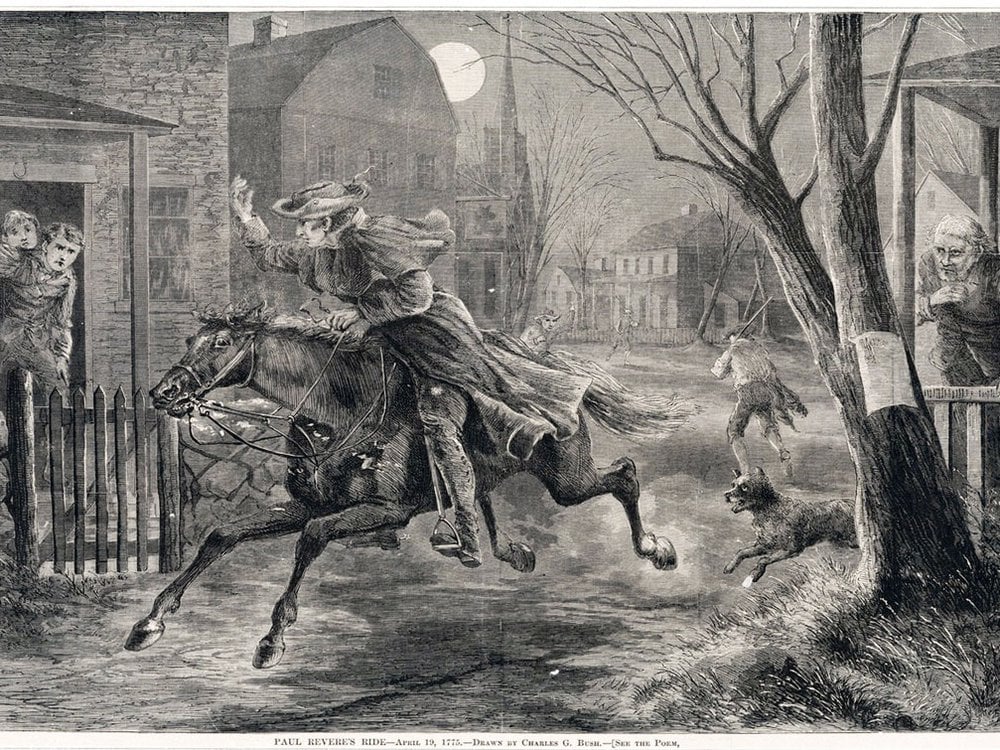Last updated on December 17th, 2022 at 09:01 pm
Tactics of war and battle have come long since the Revolutionary War. With advanced technology like radars, radios, and more, troops have several ways to determine if their enemy is approaching closer.
However, during the 1700s, this technology didn’t exist, leaving many soldiers in the Revolutionary War to rely on messengers or signals to be dissipated, indicating an attack was on its way.

This was the case on the evening of April 18, 1775, when Paul Revere conducted his historic ride from Boston to Lexington, alerting fellow Patriots that the British were starting their advance to Concord and that soldiers should get prepared to fight.
In Henry W. Longfellow’s poem, “Paul Revere’s Ride,” the poet wrote:
He said to his friend, “If the British march
By land or sea from the town to-night,
Hang a lantern aloft in the belfry arch
Of the North Church tower as a signal light,–
One if by land, and two if by sea;
And I on the opposite shore will be,
Ready to ride and spread the alarm
Through every Middlesex village and farm,
For the country folk to be up and to arm.”
Longfellow’s poem, published in 1860, was written almost a hundred years after the famous ride but solidified Paul Revere’s contribution to the American Revolution for all of history.
The poem references how the North Church’s tower would signal others about the Red Coats route — One lantern meant that troops were going the longer route by land through the Boston Neck. In contrast, two meant they were choosing to take siege on the water on the Charles River, giving them less time to prepare for their attack.
However, the poem is slightly incorrect in indicating that Revere would begin his ride when he saw the light signal in the tower. The signal in the tower wasn’t for Revere — but actually by Revere for the people in Charles Town.
Two days before the famous ride, on April 16, Revere began hearing that a raid was planned for Concord. As Revere prepared for a possible attack from the British, he knew he’d have to ride from Boston to Concord, alerting citizens of what was to come.
He worried that he might be arrested on his journey and wouldn’t be able to get the warning out in time. Revere worked to set up a backup plan that would still get the word that the British were coming.
Revere met with Robert John Newman, Captain John Pulling, and Thomas Bernard to do this. These three fellow Patriots worked with Revere to orchestrate the lantern signal in case Revere could not make it across the river to the small borough across Boston or in case he was arrested.
The Old North Church was Boston’s tallest building at the time, with a nearly 200-foot steeple that could be seen from any direction. A light signal in the church’s tower would alert those across the river. Robert John Newman was the custodian of the Old North Church and a trusted ally of Revere’s.
On the night of April 18, 1775, as the British soldiers left Boston Commons and rowed to Cambridge, it was clear they had chosen to take the longer route and go by water instead of by land to approach Concord.
When this became evident, Robert John Newman and Captian John Pulling carried the two lanterns to the church’s steeple. Thomas Bernard kept watching out front, ensuring they could carry out the alert without getting arrested.
While the two-lantern signal was only up for a brief moment, it was enough for the men of Charles Town to begin their preparations for battle. They began hiding their horses and spreading the word to head to Concord to defend the land.
Meanwhile, Revere could row across the Charles river and alert Colonel Conant and other Sons of Liberty members about the British’s journey, but they had already seen the signal in the tower.
Confirming that the men of Charles Town were informed, Revere borrowed a horse and set off around 11:00. He traveled through Menotomy and Medford’s spy routes to Lexington, where John Hancock and Samuel Adams and were staying.
While history depicts Revere as riding through the night on his own, he was actually accompanied by other Patriots, including William Dawes, Samuel Prescott, and others whose names have never been mentioned. Once they arrived in Lexington, Revere was able to get Adams and Hancock to safety and avoid arrest by the British army.
Revere is known in modern-day history for his famous cry, “The British are coming!” the reality is that he likely rode through the streets yelling, “The Regulars are coming.” Regulars were the name for British militia, as, at the time, everyone was considered British before the Revolution.
Revere didn’t make it to Lexington and was arrested by a British patrol, but Prescott and Dawes escaped. It didn’t matter, though. Revere had done his part — He had successfully warned of the attack.
Shortly after, the Battle of Lexington and Concord began, where “the shot heard ‘round the world” occurred, signifying the beginning of the American Revolutionary War. Revere was eventually released and made it to Lexington to witness part of the battle on Lexington Green.
Henry Wadsworth Longfellow’s poem has certain inaccuracies in it but tells the story of how American Patriots contributed to their country’s freedom. Longfellow’s poem was the first historical account of Revere’s ride.
It was published right before the Civil War, serving to remind readers of the patriotism that was exhibited in other tumultuous times in the young country’s history.
Today, the Museum of Concord has Paul Revere’s original lantern on display, and it has become a symbol of the American Revolution. While Revere’s lantern signal was just a backup plan, it has solidified itself as a part of America’s founding history.

